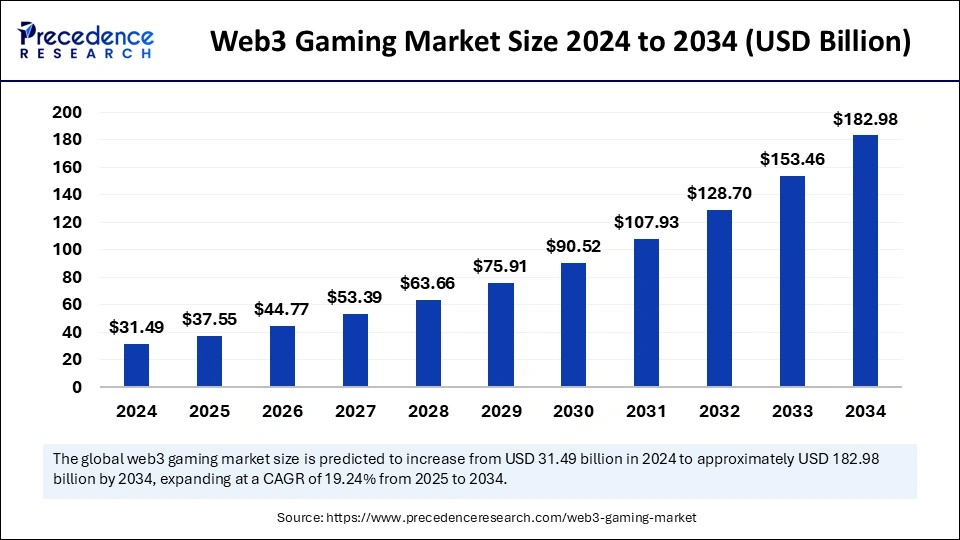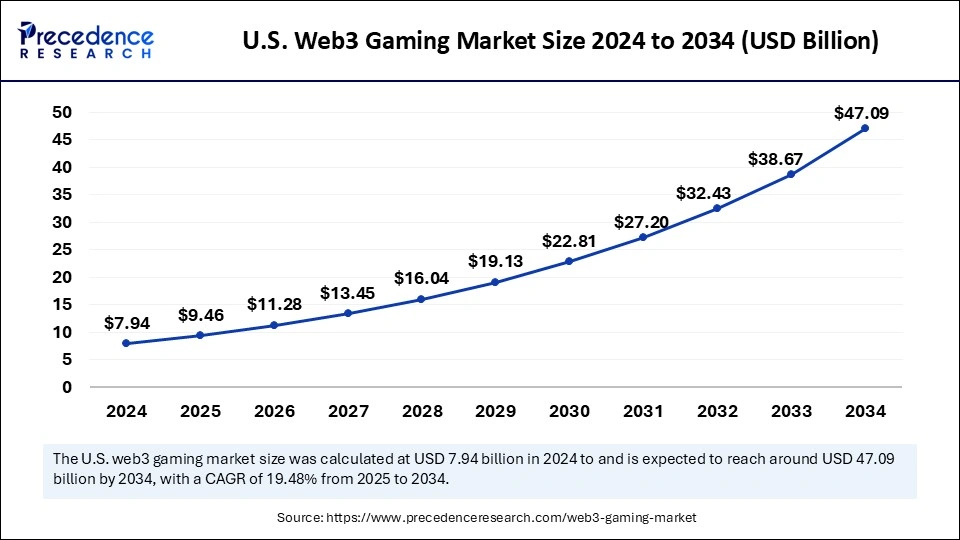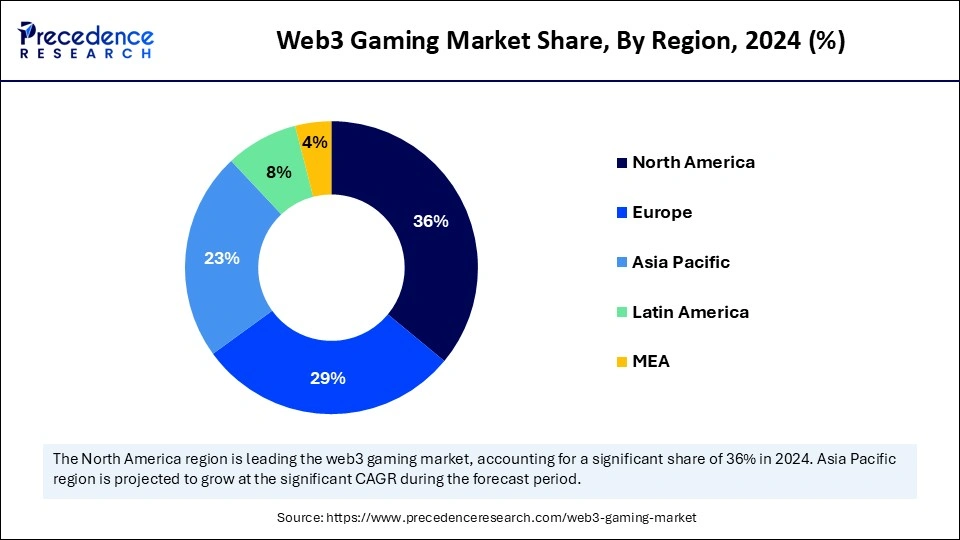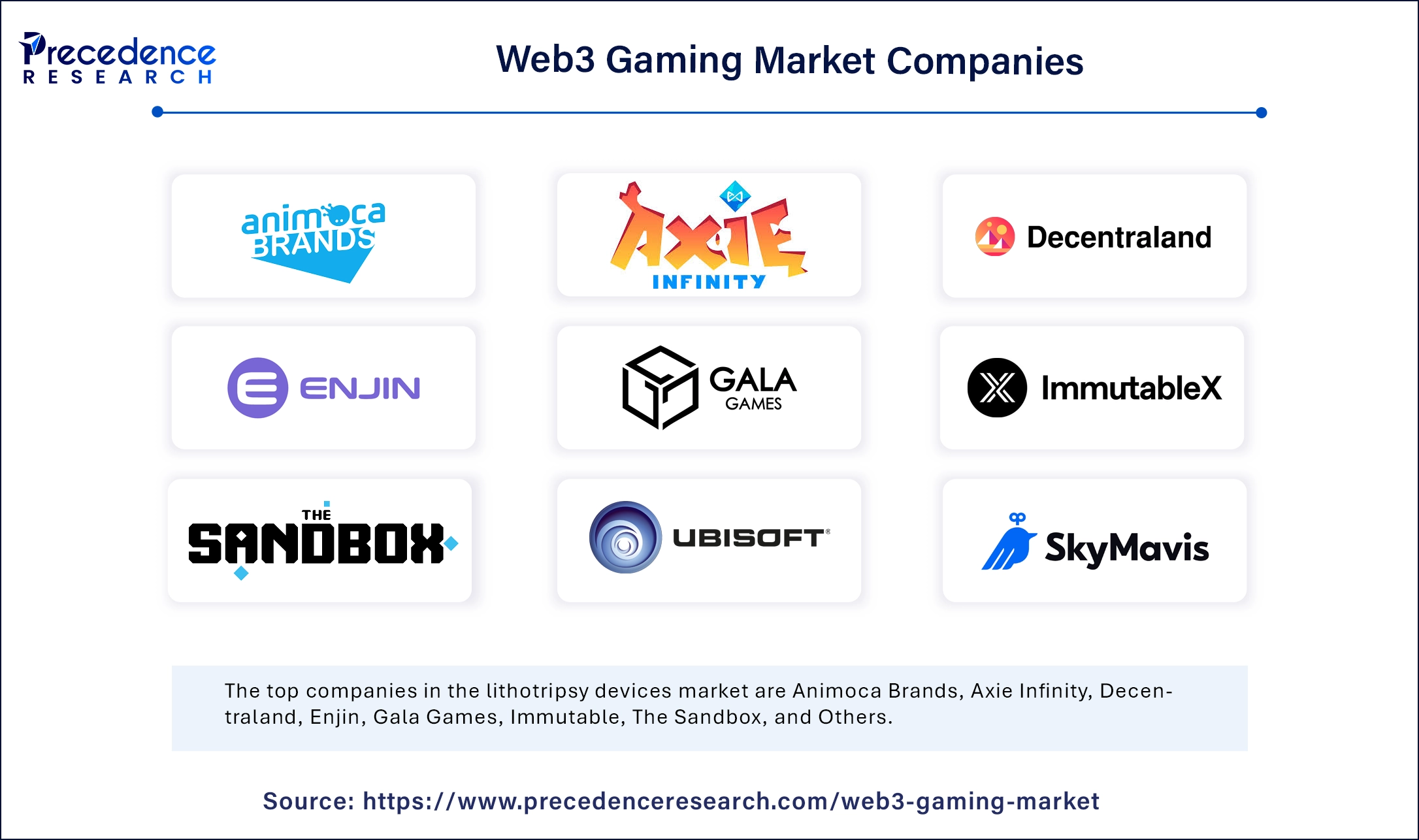January 2024
The global web3 gaming market size is accounted at USD 37.55 billion in 2025 and is forecasted to hit around USD 182.98 billion by 2034, representing a CAGR of 19.24% from 2025 to 2034. The North America market size was estimated at USD 11.34 billion in 2024 and is expanding at a CAGR of 19.40% during the forecast period. The market sizing and forecasts are revenue-based (USD Million/Billion), with 2024 as the base year.
The global web3 gaming market size was calculated at USD 31.49 billion in 2024 and is predicted to increase from USD 37.55 billion in 2025 to approximately USD 182.98 billion by 2034, expanding at a CAGR of 19.24% from 2025 to 2034. The growing shift toward player-centric and inclusive gaming experiences drives the growth of the market.

Artificial intelligence (AI) is making its way into different industries, and gaming is no different. AI technology helps in enhancing the gaming experience. With AI-driven tools, it is possible to enhance in-game asset creation, curating the setting environment, equipment, vehicles, weapons, artifacts, and avatars, which significantly improves the gaming experience. For example, text-to-image generative AI models can boost creativity and content through simple text descriptions. AI can enhance the content and visual effects of web3 gaming through AI-generated images and videos. Every character can be customized by the user using AI tools. Moreover, AI helps developers create immersive and engaging games by generating realistic characters.
The U.S. web3 gaming market size was exhibited at USD 7.94 billion in 2024 and is projected to be worth around USD 47.09 billion by 2034, growing at a CAGR of 19.48% from 2025 to 2034.

North America held the largest share of the web3 gaming market in 2024. This is mainly due to its robust and well-established gaming industry, making it a fertile ground for web3 gaming. Technology like VR and Blockchain in the gaming industry is highly adopted to enhance gaming experiences. The region boasts a large number of tech-savvy gaming populations. The region is home to major tech companies that are engaged in developing innovative games, supporting regional market growth.
The U.S. plays a major role in the North American web3 gaming market. The rising adoption of blockchain and AR/VR technologies in the entertainment sector is expected to drive market growth in the country. The Gamer population in the country is actively seeking solutions to enhance the gaming experience and earn from gameplay. The growing popularity of mobile gaming and the availability of advanced gaming devices further support market growth.
Asia Pacific is expected to witness the fastest growth during the forecast period. The rising Gamer population is a key factor boosting the growth of the web3 gaming market in Asia Pacific. In 2024, Asia Pacific had 1.5 billion gamers, which is more than any other region. There is a presence of a large number of gaming companies in countries like Japan, China, and South Korea. With the growing focus on enhancing the gaming experience, there is a rising adoption of innovative technologies like blockchain. China is expected to play a significant role in the growth of this market. The country boasts some of the well-known gaming companies like Tencent. Such companies' push for decentralized gaming experiences is likely to fuel market growth. Moreover, the rising popularity of mobile gaming contributes to market growth.

Europe is expected to witness notable growth in the foreseeable period. The country has a robust gaming industry. As of 2024, there were approximately 715 million gamers in Europe. Such substantial pollution, with an inclination for gaming, is a major factor boosting the market growth in the region. Countries like the UK and Germany are major contributors to the regional market growth. This is mainly due to the increasing popularity of NFT games.
The web3 gaming market has witnessed steady growth in the last few years due to advancements in gaming technologies. The adoption of blockchain technologies has increased in gaming, enhancing the gaming experience. A growing digital asset ownership is expected to propel the market growth. Continuous innovations like play-to-earn models and integration of NFTs are boosting the demand for these games as they improve user experience. The shift to decentralized gaming platforms that help add value for the players in the game and engage in different ways is helping the growth of this market. The availability and accessibility to electronic devices suitable for gaming have improved worldwide, helping drive the market and attract more consumers. Key players are focusing on developing players-centric games, which is aiding this market’s expansion. Technological advancements have improved and enhanced the quality of players' experience through characters, rewards, graphics, real-world value, etc. Moreover, the rising popularity of online gaming is supporting market growth.
| Report Coverage | Details |
| Market Size by 2034 | USD 182.98 Billion |
| Market Size in 2025 | USD 37.55 Billion |
| Market Size in 2024 | USD 31.49 Billion |
| Market Growth Rate from 2025 to 2034 | CAGR of 19.24% |
| Dominated Region | North America |
| Fastest Growing Market | Asia Pacific |
| Base Year | 2024 |
| Forecast Period | 2025 to 2034 |
| Segments Covered | Game Type, Device Type, End Use, and Regions |
| Regions Covered | North America, Europe, Asia-Pacific, Latin America and Middle East & Africa |
Utilization of Blockchain Technology in Gaming
The continuous integration of blockchain technology into gaming is driving the growth of the web3 gaming market. Blockchain technology is the backbone of web3 gaming. Blockchain technology enables actual ownership of the assets in the game, such as characters, armor, skin, and NFTs (Non-Fungible Tokens). This eliminates the risk of assets being stolen or lost. Additionally, blockchain technology provides players with capabilities to exchange or sell assets. It also enables the development of pay-to-earn (P2E) models, further enhancing the gaming experience. Blockchain technology empowers players to have full control over their assets, enhancing transparency and security. Such advantages of blockchain technology have consistently increased its usage in gaming.
Fluctuating Costs and Regulations
The constant fluctuations in the prices of NFTs and cryptocurrencies are limiting the growth of the web3 gaming market. The fluctuation in costs directly affects the value of rewards and purchase items in the games as it creates an uncertain environment for the players as well as developers. Assigning value to the in-game assets becomes difficult because of inconsistency in these digital currencies, which affects the player’s experience. It can discourage the players from investing their time, efforts, and resources if the value of purchases or rewards is not properly framed. Another aspect is that the different regulation related to digital currencies in different regions makes the widespread landscape unclear for the market players. Key market players must work on finding solutions to manage the regulations and fluctuating prices without hindering the gaming experience for users.
Cross-Platform Interoperability
The cross-platform interoperability offers lucrative growth opportunities for the web3 gaming market. Interoperability can create a balanced environment for the players to utilize their digital assets across different platforms, which directly magnifies the value of these assets and adds more value to the games. It can be similar to the creation of a metaverse, where the virtual worlds are connected and can move their assets. This can further help with broadening the consumer base by adding more value to players and expanding digital ownership for multiple platforms.
The play-to-earn games segment held the dominant share of the web3 gaming market in 2024. This is mainly due to the increasing desire among players to earn from gaming. These games offer players the potential to earn through gaming, making them a popular choice. Gamers often feel their time and effort are worth it because of this P2E model, leading to widespread adoption and attracting more gamers, especially those seeking to earn through gameplay.
Meanwhile, the NFT games segment is expected to grow at the fastest rate in the coming years. NFT games utilize blockchain technology, enhancing player engagement and gaming experiences. These games offer players true ownership, monetization opportunities, and new ways to engage with virtual worlds. The transparency and security offered by these games and ownership of digital assets make them a suitable choice among hardcore players.
The VR/AR segment led the web3 gaming market with the largest share in 2024. A rise in integration of Augmented Reality (AR) and Virtual Reality (VR) has improved the quality of immersive gaming experiences. These devices offer a more realistic gaming experience, interactivity, higher engagement, and spatial awareness than traditional devices. Such features make these devices a popular choice amongst the users. The growing accessibility and availability of VR/AR devices combined with technological advancements further bolstered the segmental growth.
On the other hand, the PC/Desktop segment is predicted to show the quickest growth during the forecast period. Technological advancements have improved the functionality and efficiency of these devices, significantly enhancing the visual and computational processes. The high performance of these devices makes them suitable for web3 gaming. These devices' affordability and easy availability are boosting their adoption, supporting segmental growth.
The hardcore gamers segment led the web3 gaming market in 2024. Web3 gaming focuses on redefining ownership in the gaming industry, making it an attractive choice for hardcore gamers. Hardcore gamers often look for immersive and unique gaming experiences and player-centric models. Web3 gaming offers hardcore gamers features such as enhanced security, asset ownership, and virtual worlds. Moreover, the introduction of play-to-earn (P2E) games further increased the adoption of web3 gaming among hardcore gamers.
On the other hand, the casual gamers segment is likely to grow rapidly during the projection period. The growing accessibility and availability of these games and models like P2E are attracting more casual gamers. Technological advancements and easy user interface support segmental growth. These games provide opportunities to earn from gameplay, attracting more casual gamers.

By Game Type
By Device Type
By End-Use
By Region
For inquiries regarding discounts, bulk purchases, or customization requests, please contact us at sales@precedenceresearch.com
No cookie-cutter, only authentic analysis – take the 1st step to become a Precedence Research client
January 2024
May 2023
November 2024
August 2024